Birds are without question the most prevalent tetrapod vertebrates in today’s world and for many people, especially in urban settings, birds are the most intimate link to the natural world available. Step outside, no matter where you are, you’re likely to see or hear a bird. Even as a write, I can see about a dozen birds at my bird feeder. As such, bird watching is one of the most popular outdoor hobbies, with over 50 million birders in North America alone. In addition, many more people put out bird feeders, bird houses, or construct bird friendly gardens. So, with that in mind, where are all the toy birds? Oh, I know, they exist. I’m being hyperbolic. But considering the number of species there are, and how important they are in our lives, they’re severely underrepresented.
Today we’re looking at Safari Ltd.’s attempt to bring at least a small handful of birds into the limelight with their Backyard Birds Toob, a collection of North American birds that are frequent visitors to backyard bird feeders and gardens. The toob contains 7 figures and all but one of them are passerine birds, the order that includes the “perching” or “song” birds, and with over 6,500 species is also the most species rich bird order. As is usually the case, the birds in the toob are mostly males, which tend to be more visually stunning than the females. All the figures are intricately sculpted with fine feather details and well represent their species.
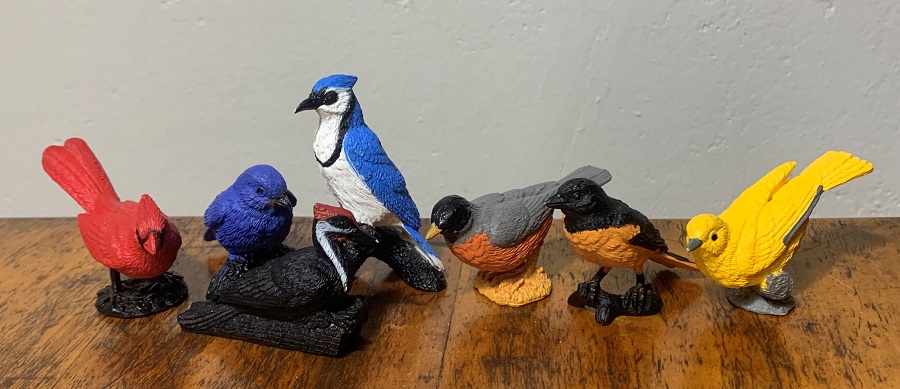
Pileated Woodpecker (Dryocopus pileatus): The first bird we’ll look at is also the only bird that’s not a songbird. The pileated woodpecker, like all woodpeckers, belong to the Piciformes order. In the absence of the ivory-billed woodpecker it is the largest woodpecker in North America. They range from the east coast of North America, across northern Canada, and along the Pacific coast. They are absent from much of the central and south-west U.S. as well as northern Canada. The figure measures 2” in length and is presented clinging to a tree branch. The branch it’s on is the same black color as the bird which I find unattractive. The toy is about 1/9 in scale but be warned, my scale estimates are going to be rough.
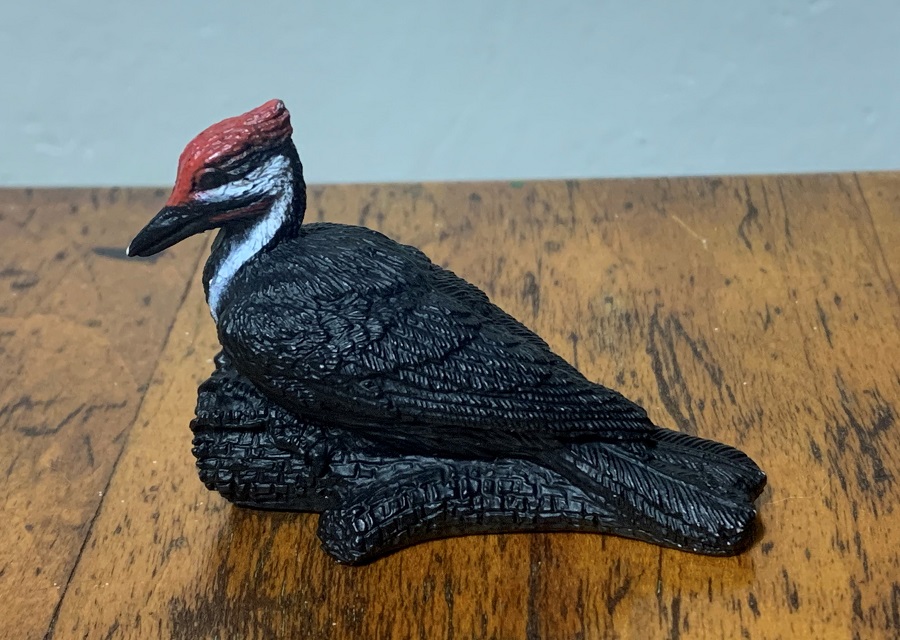
Blue Jay (Cyanocitta cristata): This member of the corvid family is among the most common, striking, interesting, and vocal backyard bird species. It can also be somewhat of a nuisance, outcompeting smaller birds at backyard feeders. The blue jay ranges across southern Canada and the U.S. east of the Rocky Mountains. West of the Rockies it is replaced by the Steller’s jay. This figure is presented standing erect on a black tree branch. This figure could me a male or female as both sexes are visually identical, with males being slightly larger. The figure lacks many of the finer color and pattern details on the wings but is otherwise obviously a blue jay. It stands 2 1/8” tall and is roughly 1/5 in scale.

American Robin (Turdus migratorius): With a range that covers nearly the entire North American continent the American robin is a quintessential backyard bird. Even in manicured suburban landscapes, the American robin can be seen hopping about lawns, probing for worms and insects. The American robin is a member of the thrush family, and not closely related to the European robin which is a member of the old-world flycatcher family. This robin is presented on a flat, rough textured, brown base that’s the same color as its feet. The figure measures 2.5” in length and is about 1/4 in scale.
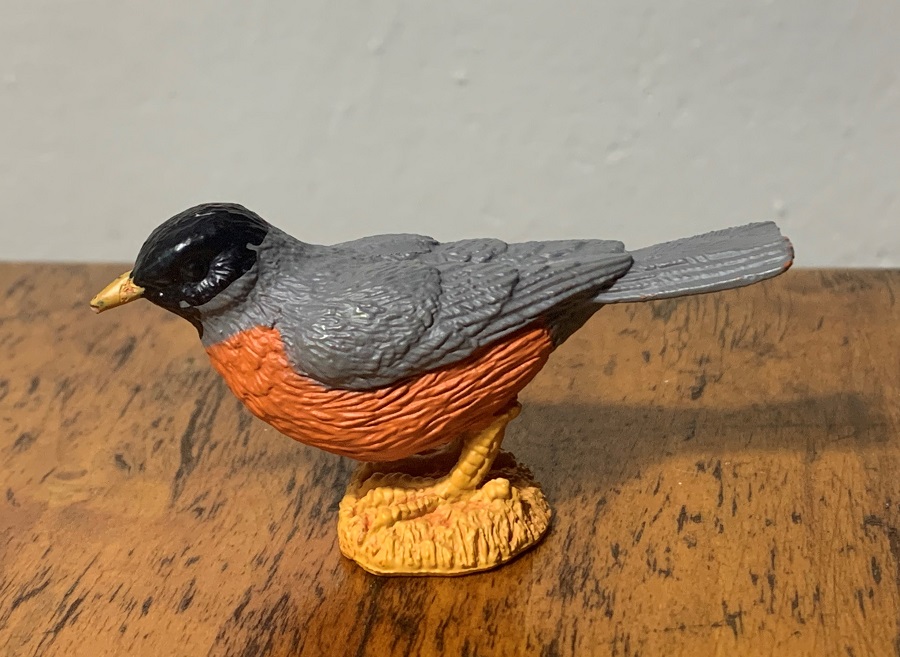
Northern Cardinal (Cardinalis cardinalis): For those of us that put out bird feeders the northern cardinal is a frequent visitor we never get tired of seeing. The vibrant red color of the males stands out in any setting, but especially so during the winter months when bird feeding is most common. This bird is a member of the cardinal family and ranges over much of the eastern United States, west to Texas and small portions of the southwest, south into most of eastern Mexico. It can also be found in small portions of southern Canada and some portions of Central America south of Mexico. The figure mostly gets the coloration right, but the legs are painted black like its flat base, instead of the pink color the actual bird has. The figure measures 2.5” long and is about 1/3.6 in scale. This figure has a larger counterpart too, a part of Safari’s Incredible Creatures line.
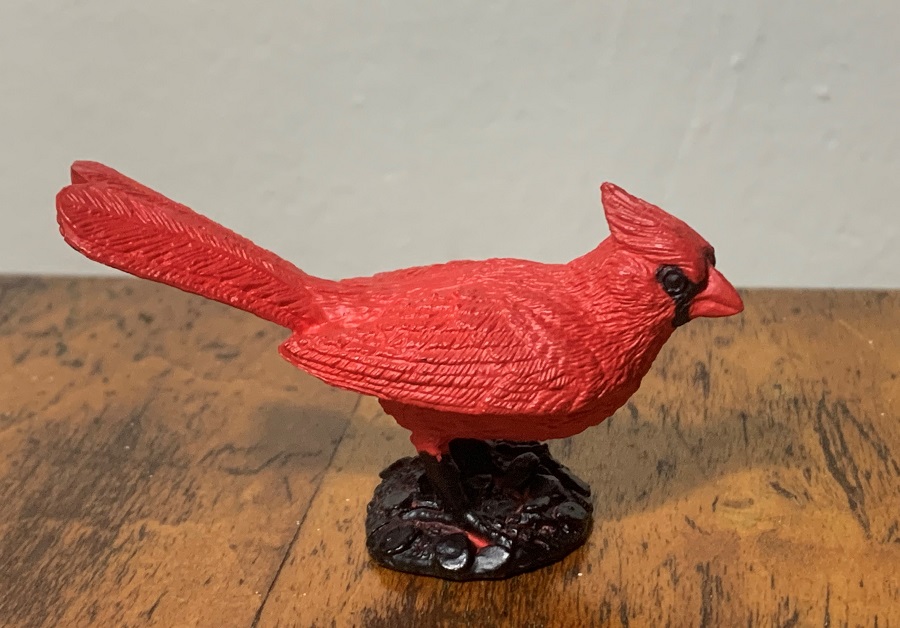
Baltimore Oriole (Icterus galbula): The Baltimore oriole is a member of the blackbird family that breeds in much of central and eastern North America and spends its winters in Florida, Central and South America, and a small portion of California. Although it is certainly a common backyard species it is not as often seen as most of the birds we’ve looked at so far. Their diet mostly consists of fruit and insects so they don’t frequent conventional feeders, but they can be attracted with orange halves or sugar water solutions in oriole specific feeders. The figure gets the orange and black coloration right but fails to depict the white wing bars. The figure stands on a black tree branch and measures 2 1/8” long, it’s about 1/4 in scale.

Indigo Bunting (Passerina cyanea): The indigo bunting is a small member of the cardinal family that ranges over portions of southern Canada and the United States east to Texas, as well as Central America and the Caribbean Islands, depending on the season. During the breeding season males are vibrant blue with indigo-colored heads. As backyard species go, they aren’t what I would consider common, although the species itself is. The figure is sculpted on a black tree branch and is painted entirely in the same flat blue color, with no hint of the subtle gradations of color present on actual buntings. The wings don’t have the black-with-blue edges present on actual buntings, and the bill is black when it should be gray.
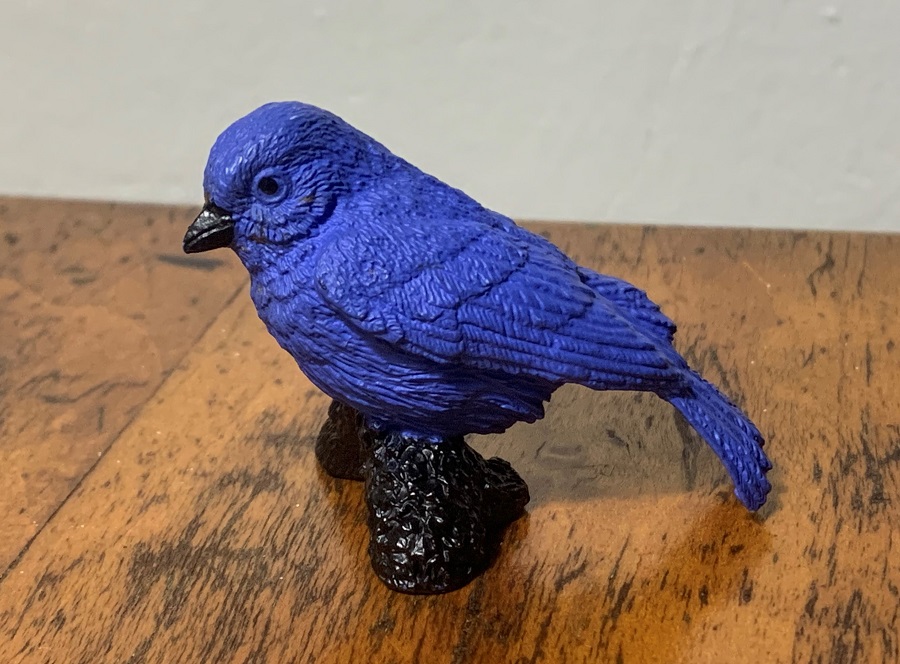
Yellow Warbler (Setophaga petechia): This species is a part of the new-world warbler family and is perhaps the most common of all warblers in North America, for me the yellow warbler was the first warbler species I ever documented, and I imagine that’s the case for many. It has an astonishing range, from Alaska and northern Canada, through the entire United States, south to northern South America. Like the bunting though, I’m not sure I would consider it a backyard bird. You might see one there, but it’s not as frequent a visitor as a slew of other species. This is the only bird in the set that can be confidently identified as a female, as it lacks the brown streaking present on the chest of males. Of course, this wasn’t likely an intentional choice. A single brown-colored edge is present on each wing but really there should be one on each feather. The figure is sculpted onto a gray tree branch and measures 2 3/16”. It is about 1/2.4 in scale.
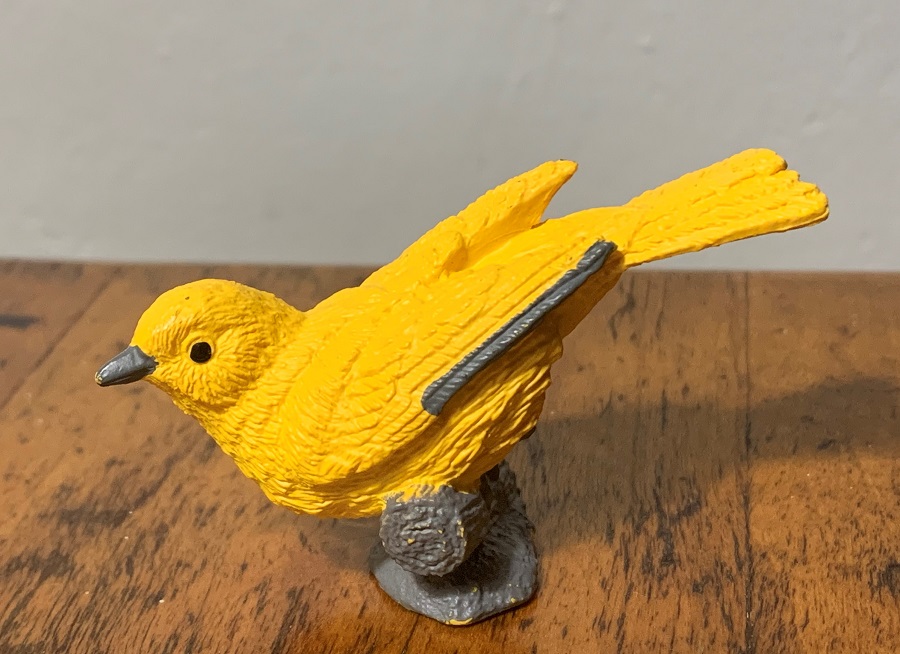
Overall, this is a fantastic set, each one of these birds is wonderfully sculpted and for being toob figures are exceptional in quality. Many of them do have inaccurate, minimalistic paint jobs but given their small size, and the cheap price of the toob, I think that can be forgiven. My only real complaint is that almost all of the bases are black tree branches, which just looks strange. Most of these species are indeed common backyard species, with a few being slightly less common. Safari could potentially make several more bird toobs, consisting of other backyard/feeder species or even just taxonomic families like warblers or sparrows. Hopefully in the future we get better representation for some of these wild animals that enrich our lives like no other can. This toob barely even scratches the surface, but it’s a start.
Disclaimer: links to Ebay and Amazon on the AnimalToyBlog are affiliate links, so we make a small commission if you use them. Thanks for supporting us!




WOW!!!!!!!!!! Thank you for reviewing this. Amazing set. I bought the TOOB for my Synoptic Collection and retained all but the woodpecker (nice species, but the sculpt it too ‘off’ for my liking).
I have re-evaluated this figure (thanks to this post) and will retain it after all (luckily, I still had it in my ‘charity box’ of figures to be donated).
Glad you decided to keep it. Are there even any other pileated woodpecker figures out there?
Thanks for introducing me to these North American birds. This is a great set and a great review. The only reason I’m not getting this set is because I don’t collect figures if they are permanently attached to a base. I think Safari can make more bird figures without bases, Papo has been managing to make small birds like that. I would be very interested in more bird toobs from Safari which have the birds without bases. Some ideas for other bird toobs Safari could make are European birds and pond birds.
I’ve ended up getting this set, for the American robin, a species I like a lot. I got help removing its base by a professional artist. I’m very happy with it now!